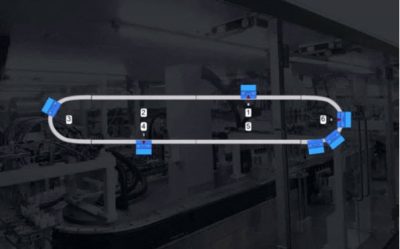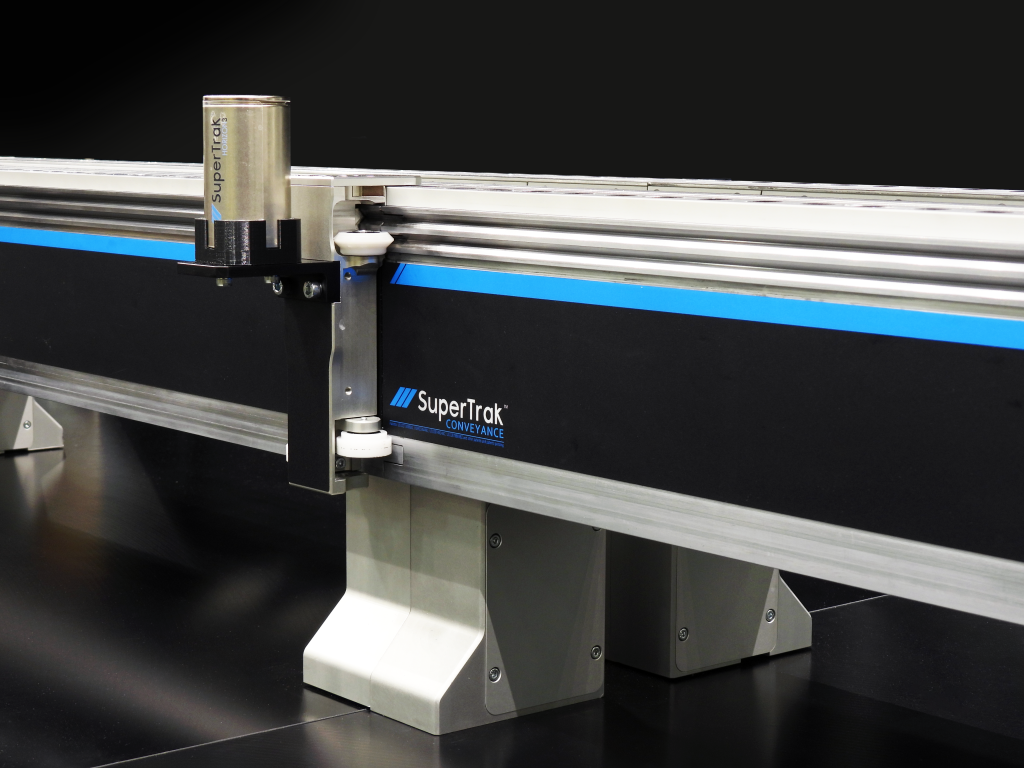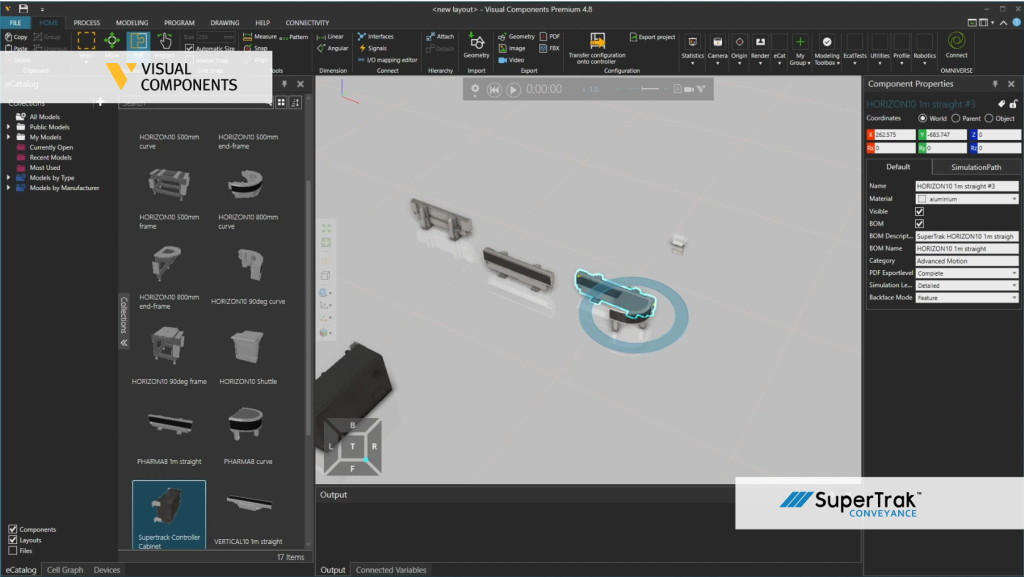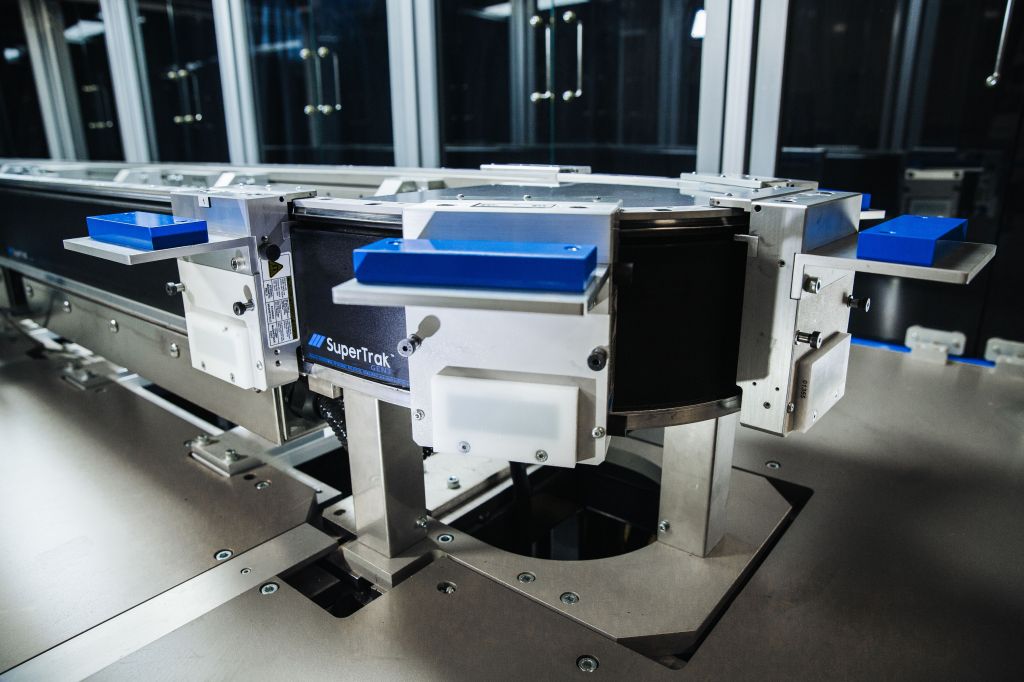When designing your factory automation, simulating your part motion helps engineers and business leaders understand how changing certain variables within the system can impact functionality and Overall Equipment Effectiveness (OEE).
Simulations help you clearly identify:
- Show the impact of station cycle times on overall system cycle time. Are there bottlenecks? Are stations over-engineered when it isn’t necessary?
- Provides insight on stations that will need more attention to reach performance goals.
- Optimize the footprint to maximize performance in the minimum amount of space.
Simulating conveyance also means that you get a clearer picture of the overall system performance. The earlier you start thinking about your conveyance and start to map it out in your simulation, the earlier you can understand how each element listed above will impact overall system performance and lead to the creation of efficient high-performing automation. SuperTrak CONVEYANCE™ General Manager, Simon Drexler talks more about this in his Ask the Expert Segment – How to Leverage Simulations to Improve the Efficiency of Your Automation.
But before you even begin to map out your process, it’s important to understand the impact your conveyance platform has on the performance of your overall automation system.
For many reasons, your conveyance platform should be considered the foundation of your automation system. In a physical sense, it literally is the bottom, or foundation, of your entire automation system. Like building a house, your foundation is the base upon which everything else is built; a miscalculation or error at this early stage in design could lead to unwanted consequences later in the build process. Continuing the house analogy, a mislaid foundation could result in unlevel walls, causing the roof to not align properly, leading to extra work to resolve the misalignments. Likewise, in automation systems, if the conveyance platform is not optimal you may require more tooling stations and a larger overall system size to reach your required Parts Per Minute (PPM). Increased tooling and footprint end up costing time and money in the long run, which is why designing your entire system from the conveyance platform as a base will allow you to reach greater efficiency in less time.
In the blog, 5 Ways Your Choice of Conveyance Impacts Your Automation, we examined the impact your conveyance has on:
- Motion
- FootPrint
- Process
- OEE (Overall Equipment Effectiveness)
- Data
It becomes clear that when you think about your conveyance early in the design phase of your automation, you are able to accomplish higher levels of automation performance, reduce engineering risks and ultimately create a higher ROI for your business.
Once you fully understand the impact your conveyance platform will have on your system and have clearly defined your automation goals, you can begin the design and development process of your factory automation.
One of the best tools our applications team uses when working with customers is the simulation tool inside our TrakMaster™ software. Very rarely is the first iteration of a design the most efficient, so the design can be modified based on changing variables. For example, if your process needs to change to accommodate new SKUs, simulations can be used to identify bottlenecks and inefficiencies in your current processes and identify areas of opportunity to optimize your system and design. Engineers realize that knowing where all parts are at any given time in a system is crucial to understanding how each process or step within the automation cell will operate. Once these factors are determined, you can begin to identify needed equipment.
To illustrate how simulations can be used to optimize your application concept, below we’ve created a hypothetical syringe assembly application using our TrakMaster™ software, which is SuperTrak’s user interface. TrakMaster™ allows you to access SuperTrak’s integrated functionality and allows engineers to take advantage of the platform’s Smart Conveyance capabilities. You can learn more about Smart Conveyance and how it can help improve the performance of your automation systems here.
This particular application example utilizes twelve parts per shuttle; some stations work on one part at a time, some work on six, while others work on all twelve. With a target throughput of 400 PPM, these simulation videos highlight how the integrated functionality of SuperTrak CONVEYANCE™ can optimize the system, increasing the efficiency from its existing 225 PPM to 450 PPM, well beyond the target goal of 400 PPM!
This is the base simulation of the original concept where we achieve a throughput of 225PPM.
- At process station 1, the syringe bodies are loaded onto the shuttle by a robot six at a time. All six loaded syringe bodies are then inspected with a camera at process station 2.
- Next at process station 3, a canula is inserted into each syringe body one at a time. Insertion depth is inspected at a vision check at process station 4.
- A process station 5, the adhesive is dispensed onto each syringe on-the-fly and the syringes are then run through a UV cure oven at a constant velocity to ensure they are in the UV cure oven for a total of 4.5 seconds.
- The syringe assemblies are then inspected with a camera at process station 6.
- Lastly, any rejected assemblies are removed, and the remaining assemblies are unloaded at process station 7.
In the original concept, process station 1, the Load Syringe Body station, is the bottleneck as it is the station with the longest cycle time. This can be seen by the queue of shuttles that has formed behind the station. By using the Simulation tool in TrakMaster™, we can easily identify this inefficiency while still in the concept phase.
In this next video, to increase the efficiency and throughput of the automation system to 262 PPM, the first improvement we make is to change the end of arm tooling on the Load Syringe Body robot from six grippers to twelve grippers.
This is a relatively simple change as the equipment feeding the syringe bodies can deliver the syringe bodies at the required rate without indexing, sending the shuttle to the base target.
Increase efficiency and throughput
With the Load Syringe Body process sped up, we now see that the queue of shuttles, the bottleneck, has moved to just before process station 3, the Insert Canula station.
Easily duplicate station tooling
In this case, this station cannot be easily changed or improved, and therefore, the best option for increasing efficiency is to duplicate the station’s tooling.
Because of SuperTrak CONVEYANCE™ ability to perform asynchronous motion, we work on multiple shuttles at once to improve the cycle time of the process at a particular station. Duplicating tooling to work on more than one shuttle or part within a station on the SuperTrak CONVEYANCE™ platform is quite simple when there is adequate space. The duplicate tooling is added, a new target is taught through the TrakMaster™ software based on the tooling location, and the shuttles coming from the previous station are distributed between the duplicated tooling.
With the duplicate tooling at process station 3, the throughput of the station is doubled to 306 PPM.
Now that the Insert Canula station is no longer the bottleneck, the simulation highlights that the next bottleneck at process station 7, Unload/Reject Assembly.
Identify system bottlenecks and inefficiencies
Since there are two operations happening at this station, the easiest thing to do is to separate these operations out into two separate stations.
Again, the simulation makes it easy to see that there is some space on the bottom side of the conveyance platform for an additional station. This allows us to relocate the Inspect Assembly station to the space along the bottom of the platform and put the new Reject Assembly station on the curve leaving the Unload Assembly station on the top of the platform.
This reconfiguration is simply done through the TrakMaster™ software by moving the target for Inspect Assembly, then adding a target for Reject Assembly, and then adjusting the routing of the shuttles through the stations.
At this point, we have not only hit but surpassed the desired machine throughput of 400 PPM.
Optimize system performance and improve ROI
Using the simulation, we can now review the entire layout to see if there are any additional improvements that can be made to improve the system efficiencies and ROI.
The first thing identified through the next simulation is that there were never more than 3 shuttles in the UV cure oven at a time. This would indicate that the cure oven length could be shortened and then reduce the velocity at which the shuttles travel through it to still achieve a total of 4.5 seconds of the product in the cure oven.
With the change to the cure oven, we have freed up some space on the bottom side of the platform and can move the Dispense Adhesive station to the bottom of the track.
All of these changes allow for a decrease in the overall size of the system while still hitting the desired machine throughput, saving on both floor space and capital cost.
Using TrakMaster’s™ simulation tool as we’ve done in these videos provides a realistic connection between conceptualization and design and ensures that your end result meets your manufacturing goals.
As you have seen in this example, thinking about conveyance early in the design phase of your automation can have significant payoffs in the long run. With the proper conveyance platform, your automation system can be more efficient, save floor space, allow for future growth capacity, and realize a better ROI.
If you have an automation project on the horizon, now is the time to start thinking about your conveyance. Contact the SuperTrak team today to request a free TrakMaster™ simulation of your process.






